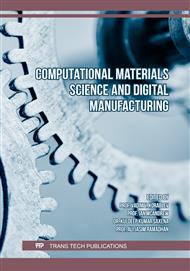[1]
Cox, L., and Van Dijk, S. (2002). Foam concrete: A different kind of mix. Concrete, 36(2), 54–55.
Google Scholar
[2]
Jones, M.R., and McCarthy, A. (2005a). Foamed concrete–development and applications. Concrete, 39(8), 41–43.
Google Scholar
[3]
Sach, J., and Sefert, H. (1999). Foamed concrete technology: possibilities for thermal insulation at high temperatures. CFI, 76.
Google Scholar
[4]
Alamayreh, M. I., Alahmer, A., Younes, M. B., and Bazlamit, S. M. (2022). Pre-Cooling Concrete System in Massive Concrete Production: Energy Analysis and Refrigerant Replacement. Energies, 15(3), p.1129.
DOI: 10.3390/en15031129
Google Scholar
[5]
Panesar, D. K. (2013). Cellular concrete properties and the effect of synthetic and protein foaming agents. Construction and building materials, 44, 575-584. doi: 10.1016/j.conbuildmat. 2013.03.024.
DOI: 10.1016/j.conbuildmat.2013.03.024
Google Scholar
[6]
Jones, M. R., and McCarthy, A. (2006). Heat of hydration in foamed concrete: Effect of mix constituents and plastic density. Cement and concrete research, 36(6), 1032-1041.
DOI: 10.1016/j.cemconres.2006.01.011
Google Scholar
[7]
Font A., M. V. Borrachero, L. Soriano, J. Monzo, A. M. Mellado Romero and J. PAYÁ, Green Chem., 2018.
DOI: 10.1039/C8GC02066C
Google Scholar
[8]
Zhang, S., Cao, K., Wang, C., Wang, X., Deng, G., & Wei, P. (2020). Influence of the porosity and pore size on the compressive and splitting strengths of cellular concrete with millimetre-size pores. Construction and Building Materials, 235, 117508. doi:10.1016/j.conbuildmat.2019. 117508.
DOI: 10.1016/j.conbuildmat.2019.117508
Google Scholar
[9]
Onprom, P., Chaimoon, K., & Cheerarot, R. (2015). Influence of Bottom Ash Replacements as Fine Aggregate on the Property of Cellular Concrete with Various Foam Contents. Advances in Materials Science and Engineering, 2015, 1–11.
DOI: 10.1155/2015/381704
Google Scholar
[10]
Barteneva, E. A., Ylesin, M. A., Mashin, N. A., & Dubrov, D. V. (2018). Improvement of Heat-Insulating Properties of Foam Concrete by Means of Mineral Additives. Key Engineering Materials, 771, 31–36.
DOI: 10.4028/www.scientific.net/kem.771.31
Google Scholar
[11]
Liu, X., Ni, C., Meng, K., Zhang, L., Liu, D., & Sun, L. (2020). Strengthening mechanism of lightweight cellular concrete filled with fly ash. Construction and Building Materials, 251, 118954.
DOI: 10.1016/j.conbuildmat.2020.118954
Google Scholar
[12]
Gökçe, H. S., Hatungimana, D., and Ramyar, K. (2019). Effect of fly ash and silica fume on hardened properties of foam concrete. Construction and building materials, 194, 1-11.
DOI: 10.1016/j.conbuildmat.2018.11.036
Google Scholar
[13]
Bing, C., Zhen, W., & Ning, L. (2012). Experimental Research on Properties of High-Strength Foamed Concrete. Journal of Materials in Civil Engineering, 24(1), 113–118.
DOI: 10.1061/(asce)mt.1943-5533.0000353
Google Scholar
[14]
Al Menhosh, A., Wang, Y., & Wang, Y. (2016). The Mechanical Properties of the Concrete Using Metakaolin Additive and Polymer Admixture. Journal of Engineering, 2016, 1–6.
DOI: 10.1155/2016/1670615
Google Scholar
[15]
Allouzi, R., Al Qatawna, A., Al-Kasasbeh ,T. (2020). Lightweight Foamed Concrete Mixture for Structural Use. ACI Materials Journal, 117(3).
Google Scholar
[16]
Md Azree, O. M., Sara, S. (2012). Effect of polypropylene fiber content on flexural strength of lightweight foamed concrete at ambient and elevated temperatures. Advances in Applied Science Research, 2 3 (5):2837-2846
Google Scholar
[17]
Xie, Yue; Li, Jun; Lu, Zhongyuan; Jiang, Jun; Niu, Yunhui (2018). Effects of bentonite slurry on air-void structure and properties of foamed concrete. Construction and Building Materials, 179(), 207–219.
DOI: 10.1016/j.conbuildmat.2018.05.226
Google Scholar
[18]
Bani Baker, M., Abendeh, R., Obaidat, T., (2018). "Employing Natural Bentonite Clay as Partial Replacement of Mineral Filler in Asphalt Mixtures". ASCE-J. Mater. Civ. Eng., 2018, 30(8): 04018167 P (1-8). DOI: 10.1061/ (ASCE)MT.1943-5533.0002375.
DOI: 10.1061/(asce)mt.1943-5533.0002375
Google Scholar
[19]
Abendeh, R., Alhorani, R., Bani Baker, M., Asaad, S., Ahmad, H. (2022). Influence of Jordanian bentonite as artial replacement of cement and fine aggregate on the workability, mechanical properties and impermeability of concrete. International Review of Civil Engineering Vol. 13, No. 3.
DOI: 10.15866/irece.v13i3.21371
Google Scholar
[20]
ACI-523, (1993). Guide for Cellular Concretes Above 50 pcf, and for Aggregate Concretes Above 50 pcf with Compressive Strengths Less Than 2500 psi.
DOI: 10.14359/11115
Google Scholar
[21]
Abendeh, R.M., Bani Baker ,M.I. (2021). Using Steel Slag Aggregate to Strengthen Self-Compacting Concrete Durability. Structures and Buildings; ICE Publishing: London, UK, p.1–15.
DOI: 10.1680/jstbu.20.00067
Google Scholar



